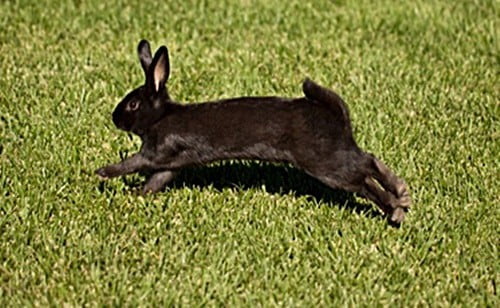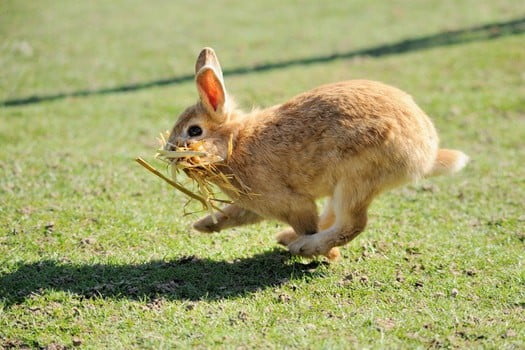When we think of rabbits, we picture them hopping around without a care in the world. This is certainly the mark of a happy bunny. These animals like to launch themselves horizontally, covering acres of ground with a single bound. Rabbit hopping is both recreational and practical.
Rabbits can walk. They move this way when exploring new territory and feeling uncertain. They prefer hopping, though. Their powerful hind legs enable them to move at speed, which is great exercise. This also helps a rabbit escape a potentially dangerous situation.
If your rabbit seems reluctant to hop, there will be an explanation. Walking is fine in moderation, but most bunnies utilize this movement sparingly. If your rabbit won’t hop, they’re likely constantly anxious, unwell, or injured.
How Do Rabbits Move?
Hopping is the preferred method of movement for rabbits due to their powerful hind legs. If investigating a new area and feeling unsure, a rabbit may prefer to walk.
The skeleton of a rabbit is designed to accommodate hopping. The bunny’s bones account for just 8% of their total body weight. Their spine is also flexible, which minimizes the impact of hopping.
When hopping, a rabbit places weight on their strong hind legs. Using these as leverage, the bunny then leaps forward. Their front paws absorb this impact, and the rabbit then repeats the trick.
The age at which a baby rabbits starts hopping depends on the bunny. Most rabbits are capable of hopping once they reach around 10 days of age. Before this, they’ll wriggle on their belly.
Typically, rabbits become more independent at around 3 weeks. If a rabbit is born in captivity, they’ll hop around their hutch at this age.
Why Do Rabbits Hop?
Hopping is ingrained into rabbits as the most efficient way of moving around. Their entire skeleton is engineered to accommodate this method of movement. The Journal of Morphology discusses a rabbit’s skeleton in more detail.
Rabbits have extremely muscular hind legs. They’re strong enough to support a bunny’s entire body weight, and pack quite a kick. They also provide a rabbit with the ability to launch themselves forward in a hop.
The primary method behind this is safety. Rabbits are prey animals, and they know it – even those born in captivity. This means that a bunny always feels safer if they can make a hasty exit.
A hopping rabbit can reach speeds of up to 50 miles per hour in the wild. If this sounds worrying, you can relax. A domesticated rabbit cannot, and will not, reach these speeds in your yard.
Pet rabbits enjoy a more luxurious diet than their wild counterparts, so they carry a little extra weight. Also, they lack the space and motivation to reach such speeds. They’ll still hop for recreation and exercise, though.
Some rabbits hop as an expression of joy. We discuss this elsewhere, as a rabbit’s hopping can reveal their mood.
Can Rabbits Hurt Themselves by Hopping?
A rabbit’s skeleton is light and flexible. This is an advantage when hopping, but it can also be a drawback. Rabbits can damage their spine if they’re not careful while hopping.
Rabbits typically hop across flat surfaces. This means they can control any jarring impact on their paws and spine. As long as they don’t hop too far, they’ll stay safe.

Rabbits are also skittish, though. This means they may leap from a height. Observe your rabbit, and ensure they do not panic and hurt themselves. Jumping out of their owner’s arms is a common cause of rabbit injury.
A rabbit should also always have a safe surface to hop on, especially indoors. Carpets and rugs are the best. If the rabbit skids while hopping, which can happen on wood or linoleum, injury can occur.
Does a Rabbit’s Hop Denote Their Mood?
You can sometimes tell a great deal about a rabbit’s state of mind by their hopping.
- A rabbit that hops forward then thumps their back legs is agitated. They’re trying to frighten a potential predator, and warn underground friends of a threat.
- A rabbit hopping toward you then stands on their hind legs is putting their dukes up. They’re angry, and challenging you to a boxing match.
- A rabbit hopping in zigzags is worried that they’re being chased. They are trying to confuse a predator by spreading their scent.
- A rabbit that hops on the spot and twists in the air is full of joy. This is known as binkying.
Watch your rabbit’s hopping, and react accordingly. If they seem frightened, remove whatever is spooking them. If they’re binkying, note what causes such good cheer and repeat it.
Can a Rabbit be Walked on a Leash?
If you’re patient, you can eventually train a rabbit to be walked. This will fly in the face of all your bunny’s instincts, though. As a result, they’ll resist the training for as long as possible.
Rabbits loathe feeling restrained. This means that the leash will feel like a mobile prison for them. They’ll also get far less exercise than they would through running free.
After enjoying a long sleep in their hutch, your rabbit will be a bundle of energy. They’ll want to race around and burn off their vigor. Not allowing them to do so will cause frustration.
There are some advantages of leash-training a rabbit, though. As the Minnesota Rabbit Companion Society explains, it’s a core part of agility training. If you are prepared to give it a shot:
- Wait until your rabbit trusts you implicitly. If you attempt leash training while your rabbit is still nervous around you, they’ll resist.
- Pick up a harness designed for a small cat. These will be more comfortable for your rabbit. Select a design that is H-shaped when flat.
- Engage in short training sessions, and always make it worthwhile for your bunny. Shower them with treats and praise.
- Start training indoors. Let your rabbit lead you around, investigating all the nooks and crannies they feel safe in.
- When your rabbit tolerates the training for more than a few minutes, move it outside.
The moment your rabbit shows any sign of discomfort with their leash, remove it. If your bunny starts to panic, they can cause themselves serious injury.
Leash training is not a substitute for free-running exercise. Your rabbit will have to stretch their legs.
It can be a useful addition to your training repertoire, though. A bunny that tolerates being walked on a leash will be safer around other pets.

My Rabbit Doesn’t Hop Anymore
If a rabbit has stopped hopping, something is wrong. Occasionally, they’re just lazy. More often it’s a serious concern though, and merits investigation.
Watch your rabbit carefully, and observe how they are moving. They’ll likely drag their back legs behind them. If a rabbit’s hind legs stop working, they will be injured or sick. Common explanations for this include:
- Arthritis in the back legs, making it painful for the rabbit to hop.
- Injury or trauma to the hind legs, leaving them too weak to hop.
- Spinal damage, which restricts your rabbit’s ability to move.
- A neurological or bacterial sickness, which impacts upon coordination.
See a professional for advice in this situation. In most cases, your rabbit can be helped with medication or lifestyle adjustments. It’s always important to take action as early as possible, though.
Also, ensure that your rabbit’s hind legs are appropriately positioned. If a rabbit has splayed legs, they may be reluctant to hop.
Rabbits with this condition can learn how to hop, and still live a full life. It depends on the severity of the splay. Rabbits with splayed leg are almost always born with the condition, so they have time to adapt.
My Rabbit Can Hop but Prefers to Walk
Every rabbit is unique. They learn at their own pace, and decide what works for them in terms of movement.
If your rabbit hops occasionally but prefers to walk, it’s not the end of the world. It does suggest that you have a nervous bunny, though. Rabbits usually walk rather than hop if they’re in unfamiliar territory.
Show your rabbit love and affection, and try to build their confidence. Bunnies really should hop, if only for exercise. Also, constant stress and anxiety can be hazardous to a rabbit’s health.
Just like humans can crawl but prefer to walk, rabbits can walk but prefer to hop. It gets them where they need to be considerably faster, and it’s great exercise.
If your rabbit is walking rather than hopping, something may be wrong. Take a look at them, and assess their health. It’s possible that your bunny is just feeling lazy. It’s more likely that their back legs are failing them, though.

